Guess what stole the headlines this week? Facebook’s local awareness ads.
This is Facebook’s latest attempt to stay in favour with small business owners, a core group of advertisers served by many social media consultants.
In fact, latest figures from Facebook show that there are more than 30 million small businesses with active pages.
In case you haven’t heard, Facebook’s local awareness ads aim to help small businesses reach potential customers nearby. As the definition suggests, it relies on the location of users and this is a potential issue that I will address in this post.
Facebook is rolling out this feature in United States and will do so globally over the next couple of months.
But even at this premature stage, I foresee some potential limitations for small businesses, that is why I am not overly excited by the prospects of the launch.
But that is not to say that nothing good will come out of this. In fact, I will share with you what I think small businesses can do with this new ad feature. And I think this will help to manage expectations of small business owners like you and your clients if you’re a consultant.
1. What local awareness ads are not good for
The first thing that jumped at me when I read Facebook’s announcement was how they will show these local awareness ads.

Image from Facebook
From the example Facebook gave, local awareness ads are as passive as the existing ad units.
In other words, Facebook will show your local awareness ad in the desktop news feed, sidebar, and mobile news feed.
Do you see what is wrong?
Users will not see your ad until they use Facebook on their own accord. This means that they probably won’t see your ad when they are nearby, unless they happen to be using Facebook.
For me, the key selling point of local awareness ads is timeliness, on top of geographical relevance. But the lack of push notifications means that the users may not be “seeing the right message at the right time”.
Of course, this is all great for users in general, especially paranoid users like me who don’t want Facebook to stalk me. But from a business point of view, that means a great deal of reduced efficacy in local awareness ads.
The nature of local awareness ads: Dual targeting
Let’s explore further to see how deep this problem may be.
Facebook purports to help small business owners reach two key groups of target audience:
- People who live near your business; and
- People who recently visited the area you selected
The problem we described above is more prominent for the second group of people than the first.
People who recently visited the area you selected are unlikely to see your ad while they are still in the area. That is a potential loss of income. But on the bright side, this leaves room for improvements in the future.
Timeliness is not the only issue
You might think that local awareness ads are at least effective in reaching people who live near your business. You might run ads to reach them and they are more likely to respond since they stay in the vicinity and could easily visit your business anytime.
But we haven’t brought up the other premise which local awareness ads are based on - location services.
In order for Facebook to recognise a user as someone who either lives near your business or have recently visited the area you selected, the user needs to turn on his or her location services. Without turning on this option, Facebook does not have information of the user. And you will not be able to reach them using local awareness ads.
Summary: What is not so good about local awareness ads
So we have concluded that local awareness ads are not timely and you may not be able to reach a lot of people who don’t have their location services turned on.
These translate to a few valuable takeaways:
- Don’t expect a huge turnout when you run time-sensitive promotions using local awareness ads
- Don’t solely rely on local awareness ads to promote your business
- If possible, make use of geographical targeting to limit the users you reach. You should avoid reaching tourists who have left the area and will never come back
- Unless you desperately want to prove Facebook ROI, don’t run Facebook-exclusive promotions because that will train your local customers to always look out for your promotions on Facebook before they buy your products or services.
On the last point, just because your customers live nearby shouldn’t entitle them to exclusive discounts unless they are providing more value than just patronising your store, such as advocating your brand to friends and tourists or returning on multiple occasions.
I decided to raise these issues with local awareness ads not to thrash Facebook, but to help small business owners manage their expectations. If you’re a social media consultant serving small business owners, you should definitely make these known to them too.
What local awareness ads are good for
The good thing about local awareness ads is that they solve a problem, and this problem exists not because of traditional media advertising but with the current Facebook ad offerings.
In fact, if you read Facebook’s post on the launch of local awareness ads, I’d like to tell you that you can ignore their distracting comparison to newspaper ads and other forms of traditional media.
Traditional advertising has always been relatively expensive and out of reach of most small local businesses. Because of this reason, I don’t think that the comparison Facebook made is useful in convincing small businesses to use local awareness ads.
What is the problem with current Facebook ad offerings?
Perhaps we are too engrossed with the wealth of new ad features that Facebook regularly bombards us with. That is why we have not realised what we are missing.
Let’s re-visit our ad setup process. I will use the Power Editor to illustrate this.

Let’s assume that I am a small business owner in Wichita, Kansas, United States. I am a firm believer of Facebook marketing and started to build my business page earlier this year.
In addition, I spend about $600 a month on Facebook ads, which translates to $20 a day.
Before local awareness ads, I’d design my campaigns to target users in my city, exactly the way Facebook allows me to in its geographical targeting.

The geographical targeting option gets me about 300,000 people living in Wichita.
Herein begs the question, “Do I really want to reach 300,000 people for a small business like mine?”
It is fine if you run an e-business and conduct transactions online. But for most small local businesses, they have a brick-and-mortar store that requires the customer to physically visit their store.
Customers that live half the city away are likely to find alternatives that are physically close to where they live.
The undeniable advantage of local awareness ads: local reach
This is where local awareness ads come in.
Now, small local business owners can choose to reach only people who show physical possibility and likelihood of visiting their store.
In fact, this narrower targeting helps to improve the way our ad budgets are spent. With local awareness ads, we can feel more assured that we are reaching only those who are or were nearby. This reduces a lot of unnecessary and wasted reach where the people who may need our product or service can find more convenient alternatives nearer to where they live.
Summary: What is good about local awareness ads
Let’s recap.
Local awareness ads, for its controlled geographical targeting ability, give the following benefits for small business owners:
- Reaching only those who show physical possibility or likelihood of visiting their store
- Improves how their ad budget is spent by not showing their ads to people who have not been to the area before, even if it means a smaller target audience
- The ability to hyper-localise their ad message. This includes speaking in your own neighbourhood lingo, cracking inside jokes, or talking up about an incident that happened in the vicinity
How to set up local awareness ads
You may find the instructions on this Facebook page. But if you’d find it more convenient, here are the same set of instructions:
1. When you first create an ad, choose “Local Awareness” as your ad objective.

2. Then, select your page as shown in the image above.
3. Next, enter your business address unless you already entered it on your Facebook info page.

4. From this step onwards, everything else is basically the same as you would when you create a Facebook ad. But you have the option to offer directions by using the Call-to-Action button.

Setting up directions is optional but recommended. After all, it does no harm to your business to help your customers get to your store, right?
It’s now your turn
I’ve done my part explaining to you what I think about local awareness ads. What about you?
Would you recommend your clients to use it if you are a social media marketing consultant?
Would you use it for your business if you are running a small local business?
Whether you would or wouldn’t, share with me why in the comments below.
I’d also appreciate if you could share this with other social media marketing consultants serving small business owners or if you have a friend who runs a small local business.
Useful resources
- Non Gamstop Casinos
- Non Gamstop Casinos
- Non Gamstop Casinos
- Casino Not On Gamstop
- Non Gamstop Casino
- Casino Sites Not On Gamstop
- UK Casinos Not On Gamstop
- Casinos Not On Gamstop
- Online Casinos UK
- Best Non Gamstop Casinos
- Sites Not On Gamstop
- Non Gamstop Casino UK
- Best Non Gamstop Casinos
- UK Casinos Not On Gamstop
- Non Gamstop Casinos UK
- UK Casino Sites
- Casino En Ligne
- Meilleur Casino En Ligne
- Non Gamstop Casinos UK
- Non Gamstop Casinos


